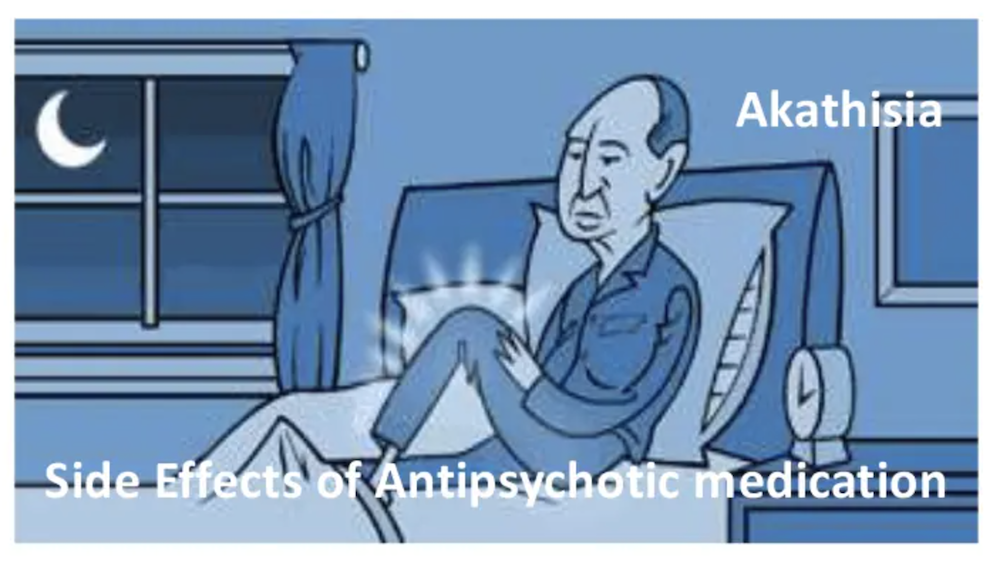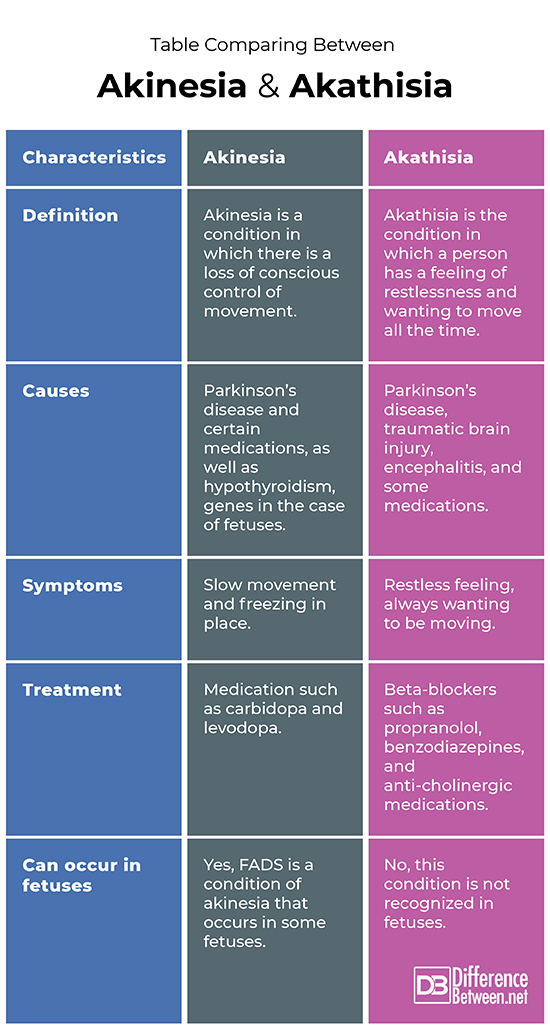Difference Between Akinesia and Akathisia
Akinesia is the condition where people have lost conscious control over their movements. Akathisia is when people feel restless and feel the need to move all the time.

What is Akinesia?
Definition:
Akinesia is defined as a type of movement disorder in which there is a loss of conscious control over movement.
Causes:
Akinesia can happen in patients who have Parkinson’s disease. In these cases, it is due to the lack of dopamine in the brain. Researchers have found akinesia to occur in almost half of patients who have Parkinson’s disease. Hypothyroidism in which thyroid hormones are low, can also lead to akinesia. The condition can also be caused by progressive supranuclear palsy (PSP), which is a progressive disease of the brain.
Diagnosis:
Diagnosis of akinesia is by a clinical examination and a noting of the symptoms. The condition is sometimes diagnosed in fetuses. This is called fetal akinesia deformation sequence (FADS), and can lead to stillbirth. Diagnosis of FADS is difficult but doctors look for decreased motility and growth restriction in the fetus.
Symptoms:
Movement is often very slow or takes too long in the case of akinesia. There is often a slowing down of motor activity and a feeling of stiffness. A person may appear to freeze in place when they have akinesia. In fetuses with FADS, joint contracture is evident and the lungs are not properly developed. Unfortunately, FADS has a high rate of death associated with it, with many stillbirths when this condition is present.
Treatment:
Medication that changes dopamine levels in the brain are helpful in controlling dyskinesia in Parkinson’s disease. Such medicine includes carbidopa and levodopa.

What is Akathisia?
Definition:
Akathisia is the condition in which a person has a feeling of restlessness and wanting to move all the time.
Causes:
Certain antipsychotic medication can cause akathisia by interfering with neurotransmitters in the brain. Akathisia can also be caused by Parkinson’s disease or traumatic brain injury. The fact that akathisia and akinesia can occur in Parkinson’s patients makes it easy to confuse the two disorders. Encephalitis, where the brain is inflamed, can also result in the development of akathisia in patients. Certain anti-emetic medications have been shown to cause akathisia in pregnant woman. Akathisia can also be a result of certain antiepileptic drugs and drugs that block dopamine receptors.
Diagnosis:
A physical exam is necessary and other conditions with similar symptoms need to be tested for and eliminated. Conditions such as ADHD and even anxiety can be confused with akathisia and thus, need to be ruled out.
Symptoms:
People with akathisia are constantly moving and fidgeting. They often move their legs around and may walk around restlessly. Patients may also feel stressed out, anxious, and generally irritable. Individuals may show anxiety and depression in addition to their movement disorder.
Treatment:
There are various medications that can be of help in treating akathisia. Beta-blockers such as propranolol and benzodiazepine medicines can work. Benzodiazepines are addictive and so are not for long-term use. Anti-cholinergic medicine and medicine like amantadine can help control movement by altering brain neurotransmitters, namely acetylcholine and dopamine, respectively. If the condition is caused by a drug, stopping the drug will bring the condition under control.
Difference between Akinesia and Akathisia
Definition
Akinesia is the condition in which there is a loss of conscious control of movement. Akathisia is the condition in which a person feels restless and wants to move all the time.
Causes
Akinesia can be caused by Parkinson’s disease and certain medications; hypothyroidism and genetics can also cause the condition. Akathisia can be caused by Parkinson’s disease, traumatic brain injury, encephalitis, and certain types of medications.
Symptoms
The symptoms of akinesia include slow movement and a freezing in place. The symptoms of akathisia include a feeling of restlessness and always wanting to move.
Treatment
The treatment of akinesia involves using medication such as carbidopa and levodopa. The treatment of akathisia involves using medication such as beta-blockers, benzodiazepines, and anti-cholinergic medicine.
Can occur in fetuses
There is a type of akinesia that can sometimes happen in fetuses. Akathisia is not a condition that is seen in fetuses.
Table comparing between Akinesia and Akathisia

Summary of difference between Akinesia Vs. Akathisia
- Akinesia and akathisia are both movement disorders that can occur.
- Parkinson’s disease can cause people to have symptoms of both akathisia and akinesia.
- Medication can be used to treat akinesia and akathisia.
FAQ
What is the difference between akinesia and dyskinesia?
In akinesia a person cannot easily move while in dyskinesia, movement may occur with no warning.
What’s the difference between akathisia and tardive dyskinesia?
In akathisia people know that they are moving while this is not the case for tardive dyskinesia.
What are the symptoms of akinesia?
Patients move very slowly and sometimes they freeze in position. They often have a hard time just trying to begin walking and find it hard to move their feet.
What is early morning akinesia?
Early morning akinesia can occur in Parkinson’s patients because the medication they took before going to bed has worn off. This means that patients have the symptoms of akinesia returning upon awaking before taking their medicine.
What does Akinesis mean?
Kinesis means movement so akinesis means the absence of movement.
- Difference Between Rumination and Regurgitation - June 13, 2024
- Difference Between Pyelectasis and Hydronephrosis - June 4, 2024
- Difference Between Cellulitis and Erysipelas - June 1, 2024
Search DifferenceBetween.net :
Leave a Response
References :
[0]Hallett, M. "Clinical neurophysiology of akinesia." Revue neurologique 146.10 (1990): 585-590.
[1]Liao, Sharon. “Akathisia”. WebMD, 2021, https://www.webmd.com/schizophrenia/what-is-akathisia
[2]Wright, Mark T. "Antiemetics, akathisia, and pregnancy." Psychosomatics 48.6 (2007): 461-466.
[3]Image credit: https://cdn.slidesharecdn.com/ss_thumbnails/akathisia-110402040243-phpapp02-thumbnail-4.jpg?cb=1301717002
[4]Image credit: https://www.google.com.ph/imgres?imgurl=https%3A%2F%2Fcdn-prod.medicalnewstoday.com%2Fcontent%2Fimages%2Farticles%2F320%2F320291%2Fakinesia.jpg&imgrefurl=https%3A%2F%2Fwww.medicalnewstoday.com%2Farticles%2F320291&tbnid=VPxIq3tWfMgayM&vet=12ahUKEwiCrp2Bt_TzAhUOAd4KHc_xDD4QMygCegUIARDOAQ..i&docid=-URCGIl4iUG6ZM&w=1100&h=744&q=Akinesia&hl=en&ved=2ahUKEwiCrp2Bt_TzAhUOAd4KHc_xDD4QMygCegUIARDOAQ
